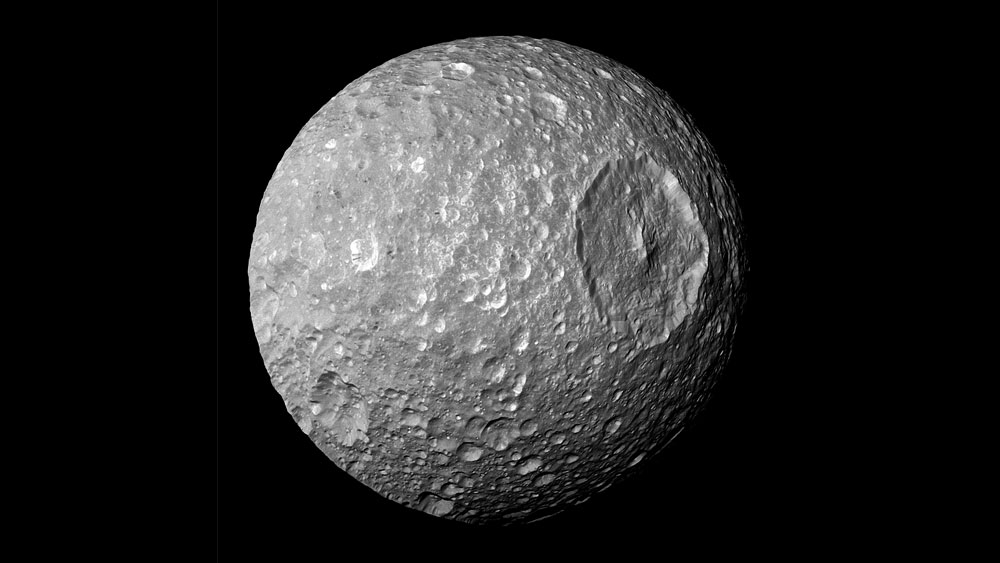Scientists have analyzed data obtained from the Cassini spacecraft and concluded that irregularities in the orbit of Saturn’s moon Mimas indicate that it contains a hidden ocean of liquid water beneath its surface.1 Similar arguments have already been published,2–4 but the fact that this result has now been published in the prestigious journal Nature suggests the evidence for this claim is stronger than before.5 Indeed, an alternate explanation for the peculiarities in Mimas’ orbital motions seems to have been ruled out.6
This subsurface ocean is thought to comprise at least half of Mimas’ volume and to be relatively young by uniformitarian reckoning, between two and 25 million years old.6
Evolutionists are excited by this, since water is essential for life. They think such oceans make the evolutionary story seem more plausible. But Earth is a veritable water world, and evolutionists still can’t explain the origin of life here on Earth.7 What makes them think finding water in space is going to help? And although water is essential for life to exist, it also causes problems for naturalistic origin-of-life stories.8
Paradoxically, Bible-believing Christians should also be excited about possible extraterrestrial subsurface oceans. A moon or planet must be fairly warm to have a subsurface ocean. For many of these moons, such as Mimas, scientists have ruled out radioactivity as a source of this heat.9 Creationists think these bodies could still be cooling off, still shedding the energy God gave them at creation just 6,000 years ago. But for scientists who believe in millions of years, this heat should have been lost to space eons ago. Thus, evolutionary scientists often invoke tidal heating or tidal flexing to explain the warmth of these small moons. In tidal flexing, gravitational tugs between Saturn and its moons stretch and compress the interiors of these moons, heating them.
Maintaining subsurface oceans requires a “fine balance between internal heating and heat loss.”10 It seems extremely unlikely that such a fine balance could be maintained for billions of years. So, some evolutionists argue that these oceans only formed recently. Another reason they must have formed recently is because tidal heating can only provide warmth for a “stealth” Mimas ocean for a short time: tidal heating requires Mimas to have an eccentric, or stretched-out, orbit around Saturn. But tides caused by the subsurface ocean would cause Mimas’ orbit to become less eccentric and more circular over time:
If such an ocean were buried there [on Mimas], its tides would iron out Mimas’s orbital eccentricity within a few million years—eliminating the very thing that can keep the ocean liquid. That means that Cassini would have to be catching Mimas at an incredibly coincidental moment in its history, just after something put the moon into an eccentric orbit that in turn heated up and created the ocean. “I find it quite implausible,” [Washington University planetary scientist William] McKinnon says.9
McKinnon thinks it is wildly improbable, in a 4.6-billion-year-old solar system, that we humans are fortunate enough to observe Mimas at such a special time in its history, one lasting only a few million years. In fact, it is precisely because Mimas’ orbit is still eccentric that researchers concluded this ocean must have formed recently.6
But McKinnon has a point. It does seem unlikely that we are “lucky” enough to observe Mimas at just such a special time. It becomes even more unlikely when one realizes that our solar system is filled with short-lived phenomena that we just happen to be able to observe.11,12 Indeed, evolutionary scientists think other moons in our solar system, such as Jupiter’s moons Europa, Ganymede, and Callisto10 and Saturn’s moon Enceladus,13 may also have subsurface liquid oceans. What are the odds that multiple bodies in a 4.6-billion-year-old solar system would just now be experiencing the necessary tidal heating for subsurface liquid oceans to exist? And what are the odds that we humans are “lucky” enough to live at just the right time to discover evidence for these oceans? This bothers evolutionary scientists because “it is statistically unlikely that humans would catch any one object [in the solar system] engaged in unusual activity—let alone several.”14
Should subsurface oceans on Mimas or other moons be confirmed by future space probes, Bible-believing Christians should rejoice. Believers in millions and billions of years are caught between two unlikely explanations for these oceans. They must either argue that an unlikely, delicate balance between heating and cooling was somehow maintained for billions of years, or they must argue that it is sheer dumb luck that we happen to be living during a short window of time in which such subsurface oceans are possible.
Although the scientists who plan the missions of space probes like Cassini may be motivated by hopes of proving evolution and discrediting the Bible, they keep inadvertently finding more and more evidence for recent creation! This should not be surprising since Scripture testifies that the Lord Jesus Christ created the universe just a few thousand years ago.15,16 It is also a reminder that, as Scripture testifies, “Surely the wrath of man shall praise You [God].”17
References
- Mimas’ surprise: Tiny moon holds young ocean beneath icy shell. Queen Mary, University of London. Posted on phys.org February 7, 2024, accessed February 7, 2024.
- Investigations reveal more evidence that Mimas is a stealth ocean world. Southwest Research Institute. Posted on phys.org January 31, 2023, accessed February 1, 2023.
- Denton, C. A. and A. R. Rhoden. 2022. Tracking the Evolution of an Ocean within Mimas Using the Herschel Impact Basin. Geophysical Research Letters. 49 (24). DOI: 10.1029/2022GL100516.
- SwRI Scientist Uncovers Evidence for an Internal Ocean in Small Saturn Moon. Southwest Research Institute. Posted on swri.org January 19, 2022, accessed March 21, 2022.
- Lainey, V. et al. 2024. A recently formed ocean inside Saturn’s moon Mimas. Nature. 626 (7998): 280–282.
- Lea, R. Saturn’s ‘Death Star’ moon Mimas may have an ocean scientists never believed could exist. Space.com. Posted on space.com February 7, 2024, accessed February 7, 2024.
- Horgan, J. Pssst! Don’t tell the creationists, but scientists don’t have a clue how life began. Scientific American. Posted on scientificamerican.com February 28, 2011, accessed February 16, 2023.
- Vieira, A. d. N. et al. 2020. The ambivalent role of water at the origins of life. FEBS Letters. 594 (17): 2717–2733.
- Hand, E. 2014. Does Mimas Have an Ocean Under an Icy Cap? Science News. Posted on science.org October 16, 2014, accessed February 2, 2023.
- Jupiter’s moons could be warming each other. University of Arizona. Posted on sciencedaily.com September 10, 2020, accessed April 8, 2022.
- Hebert, J. Youthful Solar System Bodies Puzzle Evolutionary Scientists. Creation Science Update. Posted on ICR.org February 13, 2013, accessed February 7, 2024.
- Hebert, J. 2023. Jupiter’s Young Moons. Acts & Facts. 52 (5): 14–16.
- Moskowitz, C. Liquid Ocean Sloshes under Saturn Moon’s Icy Crust, Cassini Evidence Shows. Scientific American. Posted on scientificamerican.com April 3, 2014, accessed February 9, 2023.
- McKee, M. 2013. Planetary Science: Caught in the act. Nature. 493 (7434): 592–596.
- Genesis 1:1–31, John 1:1–3, Colossians 1:16.
- Johnson, J. J. S. 2008. How Young is the Earth? Applying Simple Math to Data Provided in Genesis. Acts & Facts. 37 (10): 4.
- Psalm 76:10.
*Dr. Hebert is Research Scientist at the Institute for Creation Research and earned his Ph.D. in physics from the University of Texas at Dallas.





















